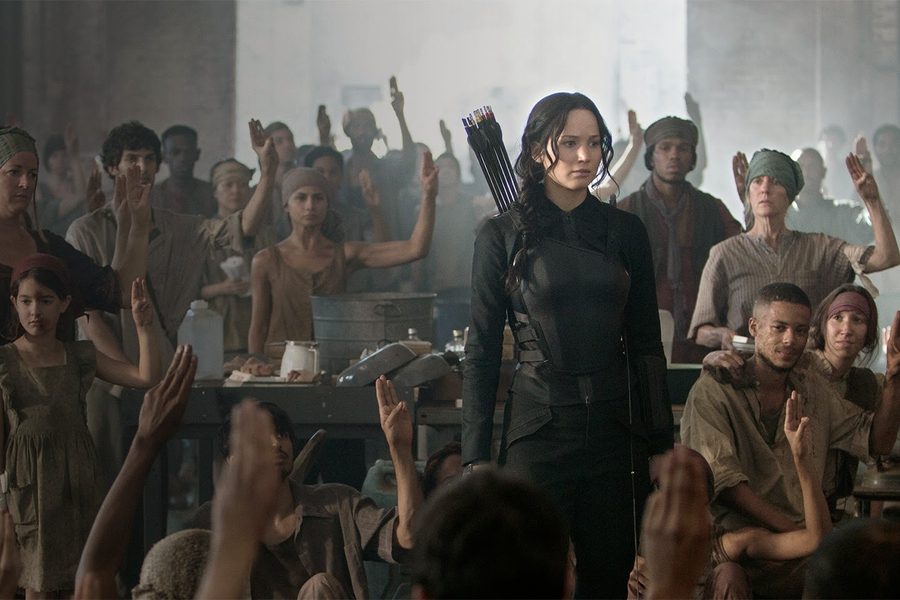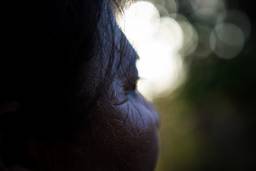Mockingjay’s Contradictory Revolution
The latest Hunger Games installment suggests that everything we do—even our resistance—is compromised.
Jude Ellison Sady Doyle

There’s not a lot of succor for those of us who are cranky and suspicious of mass culture these days.
The old dichotomies — art versus commerce, speaking up versus selling out — don’t carry the weight they once did. Celebrities increasingly bear the banner of our progressive movements, even when that means the movements themselves get a bit muddled in translation. (Taylor Swift, greeted as “feminist superhero” by MTV, recently opined that “so many girls out there say ‘I’m not a feminist’ because they think it means something angry or disgruntled or complaining. They picture like rioting and picketing, it is not that at all.” Actually, it is that — rioting, picketing, and complaining, the synonym for all of these being “protesting,” are pretty darn essential — but hey, who am I to stand in the way of mass appeal?) And it often seems hokey and naive to worry about all this; to ask whether turning revolution into a brand is a way to get tough messages across effectively, or just a new way to increase our identification and loyalty to branded products.
You could argue that it’s always been this way; Fredric Jameson worried that The Clash couldn’t stand far enough outside of capitalism to critique it without being co-opted by it. (Jameson, it turns out, was correct.) Still, it’s with a queasy sense of compromise that I tell you that one of my favorite pieces of pop culture right now is The Hunger Games: a bestselling YA book series, and now a blockbuster movie series, that is entirely about why bestsellers and blockbusters are bad for you.
And now, with the release of Mockingjay — Part 1, the series is moving into its most interesting, and most compromised, stretch: questioning not just whether mediated culture is bad for us, but whether “revolutionary” media is all it’s cracked up to be.
You’d probably have to be living under a rock to not know the plot of The Hunger Games by this point, but here goes: In a dystopian future world where most citizens live in crushing poverty, children from across the country are invited to the mega-wealthy Capitol to compete in the titular Games. They fight each other to the death on live TV, and the winner gets a lifetime of free food.
The Hunger Games are an all-inclusive media spectacle, so it’s not enough to be strong or ruthless: The audience is funding their favorite “characters.” To get weapons, food and medicine, you need to have the right outfit, give the best interviews, shape your life into the right dramatic plot arc. In a room full of murderers, you need to be the murderer people like.
Enter Katniss Everdeen (Jennifer Lawrence), who is by now a two-time survivor of the Games. She’s a stern, reserved, independent sort of young woman — a lifetime of hunting for squirrels to avoid starvation will do that to you — who became a fan favorite in the Games without entirely meaning to. And now, simply by virtue of seeming even more displeased with the Games than most of the other doomed contestants, she’s managed to spark a full-blown revolution against the Capitol.
The Capitol, naturally, has responded by bombing Katniss’s entire home district, giving her nowhere to go but the secret underground base of the District 13 revolutionaries — who, it turns out, have been planning this war for a very long time.
This is where a series that started out as a pretty sharp media satire adds another layer, and somehow gets both sharper and much, much darker. Because once Katniss is safely ensconced among the rebels, she doesn’t become their leader, or a general. Instead, she stars in their propaganda videos.
The series has focused exclusively on Katniss’s worldview up to this point. And she is, I think, a great heroine: principled, self-sufficient, strong. But the series’ focus on Katniss has allowed us to miss one of the most important things about her: She’s become the face of the revolution, but she really didn’t do anything to earn that status.
She didn’t start the war. Many of the other major players in the series have been fighting the war without her. (The entire plot of the last installment, Catching Fire, centered on a revolutionary mission that Katniss participated in without knowing it.)
We like Katniss, so we want to believe she’s important. But she isn’t a politician. She’s not a military strategist. She’s not a revolutionary thinker. She’s a survivor, and can handle a weapon, but that’s true of most soldiers. The only real value Katniss Everdeen has to the revolution is the fact that people like seeing her on television. She’s a weapon of mass sympathy; if she believes in this war, people at home will join it. And then they will die.
Meanwhile, back in the Capitol, Katniss’s main love interest and fellow Games survivor Peeta has been brainwashed into shilling for the Capitol through their propaganda. Katniss and Peeta have become enemy combatants who only interact through TV screens; as all the tense action-movie sequences about costume design and media strategy ought to tell you, the future of the world now depends on which one of these two attractive teenagers makes for a more likable celebrity. It’s a pretty grim joke, but the more you think about it, the funnier it gets.
There are lots of reasons that Hunger Games fans tend not to like Mockingjay: It’s dark, it’s cynical, it’s even more violent than the rest of the already-violent series, our heroine seems too passive or too fragile (on top of the fact that she’s largely sidelined from the war, pretty much everyone in the series, including Katniss, is dealing with severe PTSD by this point).
But there’s something real in there: The thesis of The Hunger Games has always been not that the revolution will be televised, but that the revolution will be television. Our media loyalties will be what shape our lives; people fight, and people die, but the winner is the side with the best spin.
Cynically enough, Mockingjay also argues that, when wars of spin are being fought, justice cannot be achieved: Katniss started her media career as the unwilling face of the Games, a toy war, and she’s now the face of the Rebellion, a real war. But either way, this young woman who opposes the televised killing of children is doomed to spend her life on camera, rallying support for children’s deaths.
Or maybe I’ve been tricked, too. The Hunger Games is a massive and massively well-funded product. Mockingjay — Part I is expected to do so well at the box office that no other films opened this weekend; it was considered foolish to compete. Certain aspects of it — the drawn-out and frankly pretty tiresome “love triangle” between Katniss, Peeta, and her brooding man-friend Gale — could not be more pre-fab, or more tailored to an insulting idea of what’s “marketable” for young women.
The part of the franchise that induces a sense of queasiness (and, I think, the brilliant part of it) has always been that, on some level, The Hunger Games is what it critiques: It asks us to abhor the idea that people would watch children fight to the death, but it does so by showing us riveting scenes of children fighting to the death. Now, Mockingjay — Part I asks us to be skeptical of “revolutionary” media and celebrity, but it does so by giving us a “revolutionary” blockbuster fronted by Jennifer Lawrence.
The Hunger Games series asks us, over and over, to stop thinking about how we can “win” the Games, and start thinking about how we can end them. Or, in other words, to stop trying to negotiate a more powerful position within oppressive systems, and to start thinking about how we can get outside of those systems altogether.
But Mockingjay is asking us to also consider the very real possibility that there is no “outside”; that everything we do is inherently compromised, and that no matter how much we think we hate it, we’re always playing the game.
The Hunger Games has the same problems as celebrity feminism and The Clash and everything else: It’s made by the system it critiques, and serves that system’s end goals. But the fact that the film is explicitly asking us to consider the problem inherent in its own success makes it smarter than most cultural productions — even if it offers no real answers as to whether the message or the money will win out.
Jude Ellison Sady Doyle is an In These Times contributing writer. They are the author of Trainwreck: The Women We Love to Hate, Mock, and Fear… and Why (Melville House, 2016) and was the founder of the blog Tiger Beatdown. You can follow them on Twitter at @sadydoyle.








